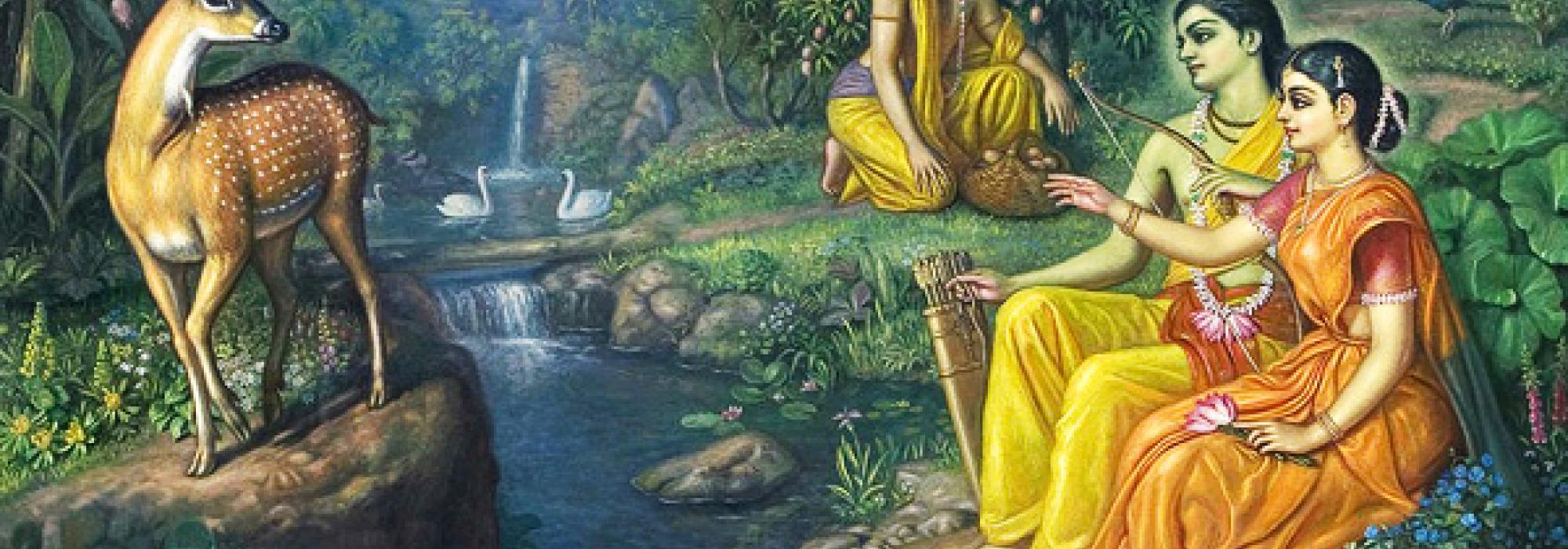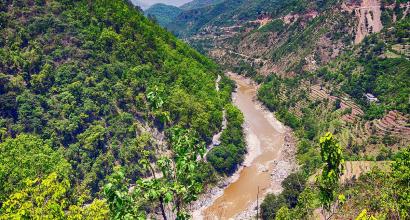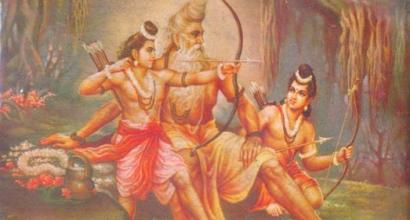Rāvaṇa said to the rākṣasa Mārīca, “My dear friend, hear me. I am in immense distress and you are my sole means of solace. You know Janasthāna, where once dwelt my powerful brothers Khara, Dūṣaṇa, and Triśiras as well as my sister Śūrpaṇakhā. As per my orders, they lived there with several other rākṣasas and constantly troubled the dhārmic munis. The brothers along with fourteen thousand rākṣasas have been slain by Rāma, who, although in rage, did not utter a single harsh word. Exiled along with his wife by his angry father, this Rāma is a disgrace to the kṣatriyas. He is wicked, hard-hearted, ruthless, and an obstinate fool. He disfigured my sister in the forest by chopping off her nose and ears, even though there was no provocation. He did so, only to display the strength of his muscle. He has a beautiful wife, who is like the daughter of a deva and I wish to carry her away. I require your help in this regard. You have no equal in might, battle, and pride. Now listen. Disguising yourself as a charming golden deer with silver spots, you must roam around in the vicinity of Rāma’s āśrama so that you catch Sītā’s eye. As soon as she spots you, she will surely entreat her husband and Lakṣmaṇa to catch you. In their absence, I will abduct Sītā, just as Rāhu kidnaps the radiance of the moon. When Rāma is overwhelmed by grief over the loss of his beloved wife, I can easily kill him and gain my heart’s desire.”
On hearing him speak of Rāma, Mārīca was dismayed and his mouth went dry with fear. Well acquainted with Rāma’s prowess, he joined his hands in reverence to the king of rākṣasas and said the following for Rāvaṇa’s good as well as his own.
“O king, it is easy to find men who always say what is pleasing; it is rare to find one who can speak the unpleasant but wholesome truths, and the man who heeds them. You clearly don’t know anything about Rāma’s might and virtues, as you don’t make use of spies. I fear no rākṣasa will be free from harm if you infuriate Rāma. Perhaps the daughter of Janaka is born for your destruction. The city of Laṅkā, which is ruled by a person like you, who is the slave of his passions, will perish, and with you, all the rākṣasas. It is wrong to say that Rāma is of bad character or a disgrace to the kṣatriyas. He was definitely not forsaken by his father. He saw how Kaikeyī had deceived his father and accepted the exile to make his father’s promise come true. Rāma neither cruel nor stupid. Rāma is an embodiment of dharma, nobility, and honesty. How do you even imagine to abduct Vaidehī, who is protected by her own blazing energy? It is like taking away sunlight from Sūrya. Why do you want to kindle the fire called Rāma and enter it by yourself? Immeasurable is his glory, the man who has married the daughter of Janaka. His wife his dearer to Rāma than his own life. You must seek the counsel of all the dhārmic ministers headed by Vibhīṣaṇa. Be sure about what you want to do; weigh the advantages and disadvantages, taking into account your strength as well as Rāma’s. Listen for a moment about my own experience.
“Once upon a time, I too went up and down the earth, proud of my strength. I went around Daṇḍakāraṇya with an iron club in my hand, unleashing terror on all beings, and feasting on the flesh of ṛṣis. The Sage Viśvāmitra, in order to get rid of me, approached King Daśaratha, and convinced him of Rāma’s power. He said to the king, ‘Though he is young, there is no power apart from Rāma to vanquish Mārīca,’ and took the prince to his āśrama. Rāma stood guard twanging his bow; clad in a single garment, he had lovely eyes, and hadn’t attained puberty yet. I entered the āśrama. Out of my arrogance as I had procured a boon and in my folly, saw him with contempt. ‘He is merely a boy,’ I thought and charged headlong at Viśvāmitra’s vedī. Rāma shot a sharp arrow, which hurled me into the depths of the bottomless ocean, a hundred yojanas away. Once I regained consciousness, I got back to Laṅkā. My companions were slain by this ‘little lad, untrained in weapon usage.’ If you lay hand on Maithilī, you will see Laṅkā reduced to rubbles in no time. Even those who haven’t committed any evil will perish through their association with vile ones like you, just like fish in a lake filled with snakes. You already have thousands of lovely women with you; be content with your wives and protect your lineage. Despite my caution, if you assault Sītā, you, along with your kith and kin will be slaughtered by Rāma’s arrows.
“Though this had befallen me, I came back to Daṇḍakāraṇya with two other rākṣasas and continued assaulting tapasvīs. As I was roaming around the forest, I encountered Rāma again, this time in the guise of a tapasvī. He was in the company of Vaidehī and Lakṣmaṇa. Considering him now to be a powerless ascetic and recalling our former enmity, I took the form of an animal and charged at him in towering rage. He shot three arrows at once, but knowing his skill, I dodged them and barely saved my life. But the other two rākṣasas were killed. I then came to this place and starting practising tapas myself. However, I am still haunted by fear of Rāma. Behind every tree, I seem to see Rāma clad in backcloth and skin of black deer, wielding his bow. In my fear, I see thousands of Rāmas. This whole forest appears to me to be nothing but Rāma. I see him in my dreams and wake up with a jolt. I am so scared of Rāma that even words beginning with ‘r’ such as ratna and ratha cause me fear. So, thus, you may fight with Rāma or merely forgive him for his deeds. But if you want to see me again, don’t ever mention Rāma.”
Though Mārīca had given him sane advice, Rāvaṇa would not accept it, just like the man who wishes to die, does not take medicine. He said, “Your advice is improper and misconceived, and is completely useless like a seed sown in saline soil. Your words cannot dissuade me from killing the foolish Rāma in the battle. He is after all a human, who went off to forest paying heed to the vain words of a mere woman. And as he has killed Khara in battle, I will abduct Sītā, a woman who is dearer to him than his own life. You may pose your arguments only when I seek them. An earnest counsellor should never speak against his king. You speak to me so harshly when I am paying you a visit! You will assist me by becoming a golden deer. Once you have done what I require of you, you may go where you please. I will even bestow half my kingdom on you, if you keep up your vow, Mārīca. If you encounter Rāma, there is some possibility of you surviving; but if you disobey me, your death is certain. Think over this carefully and do what you deem fit.”
Thus, receiving the royal commands of Rāvaṇa, Mārīca made his harsh reply: “Who was the wicked fellow who persuaded you to this course? It will surely lead to the destruction of you, your realm, and lineage. Why don’t you put such advisors to death, Rāvaṇa! Dharma and victory are rooted in a king. A king along with his counsellors who give him brutal advice will be overthrown, like chariots driven at high speeds on uneven roads by incompetent charioteers. Subjects under the governance of a crooked master will prosper no more than sheep under the protection of a jackal. Once Rāma has slain me, he will surely vanquish you. I will find fulfilment dying at the hands of my enemy. You seem to ignore my words. A man, whose life-breaths are fading will not heed to his friend’s good advice, anyway!”
Having spoken these harsh words, Mārīca, who was terrified of Rāvaṇa, said, “Let’s go! Good luck to you, O rākṣasa!”
Rāvaṇa was delighted, and embraced Mārīca warmly. They mounted the palatial chariot drawn by donkeys, flew through the air, and arrived at Rāghava’s āśrama in Daṇḍakāraṇya. Mārīca turned himself into a golden deer and started grazing near the āśrama. The tips of his horns were decked with fine gems; half his face was fair and half dark; one part of it looked like the red lotus, and the other like the blue lily; his neck was slightly stretched and his belly was shining; his hooves were like vaiḍhūrya, and his tail was lit up like a rainbow; his body was studded with all kinds of precious gems and stones that gave him a brilliant hue. In a moment’s time, the rākṣasa had turned into an alluring deer. Lighting up the woods and the āśrama, he went around grazing in the grasslands to entice Vaidehī. He wandered slowly within the range of Sītā’s vision. Going back and forth, appearing suddenly here and there, the charming deer wandered about. Having played for a little while, he would lie down on the ground. He would walk to the door of the āśrama and then join a herd of deer. He went around making different kinds of circular formations in the air. Deer and other animals came close to him out of curiosity, sniffed him, and then took to their heels, running off in different directions. In order to hide his identity, the rākṣasa did not eat the forest animals, though he would have delighted in doing so.
The deer finally caught Sītā’s eye. She was plucking flowers when she spotted the deer, which shone like gold on one side and silver on the other. She stood there in wonder, with her eyes blossomed, and staring longingly at the magical deer. She called out to Rāma and Lakṣmaṇa, who were standing guard. They looked at the deer and at once Lakṣmaṇa told Rāma, “I am sure that the deer is none other than the rākṣasa Mārīca. When kings come hunting in the forest, he takes different forms at will, and kills them. Where on earth can such a deer exist, O Rāma! This is an illusion for sure!”
Even as Lakṣmaṇa was saying so, Sītā interrupted and said in great delight, “This lovely deer enchants me. Catch him, my lord! He will be our plaything in the āśrama. Never have we seen such an animal, so brilliant and radiant. His body sparkles with different colours and is decked with precious stones. He illuminates the entire forest. What a form! What beauty! He has stolen my heart! Once our time in the forest has ended, this deer will adorn the antaḥpura in the kingdom. This deer will cause delight to Bharata and my mothers-in-law as well. If you cannot catch him alive, then I shall find delight in his golden skin. It can be spread over the green grass and can become a lovely seat. You might find my words unbecoming of a woman, but I cannot help – I am filled with wonder.”
Rāma’s mind too was caught in wonder at the sight of the golden deer. He told Lakṣmaṇa, “See how Vaidehī longs for the deer. True, it may not be a deer in reality. But who will not be astonished by its divine beauty? Kings go out hunting to kill deer for food and sport, and look for wealth and valuable mineral ores in the forests. Vaidehī will certainly sit with me on the precious hide of this rare deer. This dazzling deer and the celestial one that moves in the sky are unique of their kind. Supposing this is a rākṣasa, then, it is my duty to slay him. The savage Mārīca had killed many great sages and kings in the past. Just as Agastya digested Vātāpi, the wicked rākṣasa, in this very place, I will eliminate Mārīca. You stay here, armed and guard over Sītā. The deer is doomed to die, as its skin is most valuable. Along with the wise, devoted, and powerful bird Jaṭāyu, you must stay protect Maithilī. Be on your guard every moment and suspicious of everything!”
Having thus instructed his brother, Rāma picked up his sword, bow, and arrow and started chasing the deer. At one moment, he would spot the deer running through the forest, get ready to shoot an arrow, only to find it suddenly far away. The deer tricked Rāma – it made itself visible one moment and invisible the next. After drawing Rāma a large distance away from the āśrama, the deer was exhausted, withdrew to a shady spot in a meadow, and lay surrounded by other deer. Spying the deer, Rāma shot an arrow made by Brahmā, which penetrated the deer’s body and split Mārīca’s heart. The deer jumped into the sky, as tall as a palm tree, and fell to the ground with a ghastly shriek. As Mārīca lay there dying, he called out “Alas! Sītā! Lakṣmaṇa!” in a voice just like Rāma’s. The rākṣasa abandoned his disguise, assumed his real form, and lost his life.
When he saw the frightful rākṣasa, Rāma immediately got worried about Sītā. He wondered what she would think upon hearing Rāma’s voice calling out for her and Lakṣmaṇa. Rāma horripilated out of fear. He killed another deer, and taking its flesh with him hastened towards Janasthāna.
To be continued...
[The critically constituted text and the critical edition published by the Oriental Institute, Vadodara is the primary source. In addition, the Kannada rendering of the epic by Mahāmahopādhyāya Sri. N. Ranganatha Sharma and the English translation by Sri. N. Raghunathan have been referred.]














































